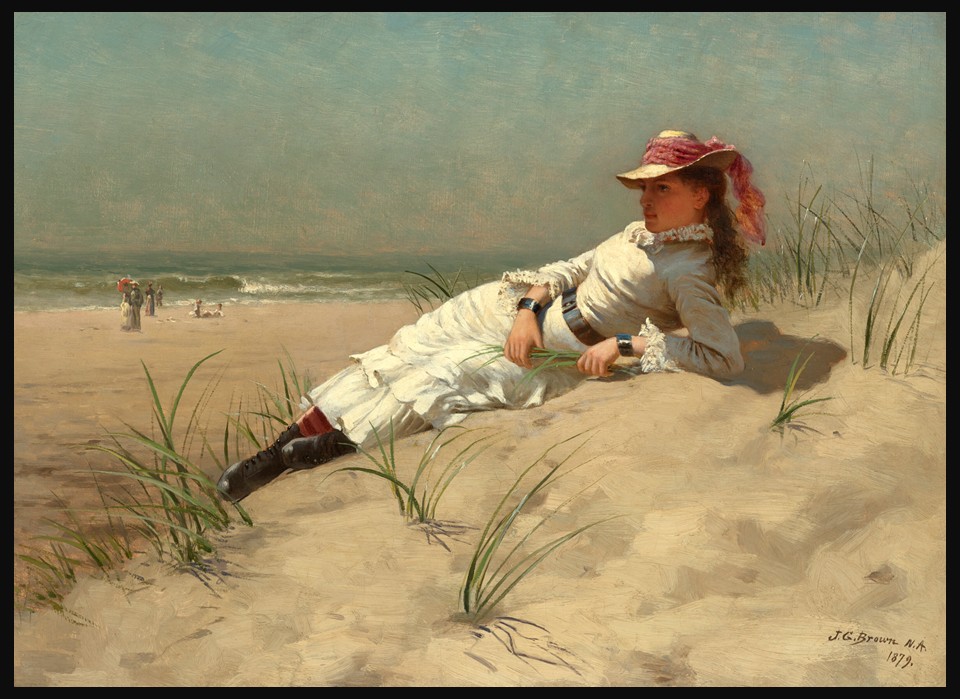
Sunshine, 1879, Oil on Canvas, 35.6 x 50.8 cm, Private Collection https://www.christies.com/en/lot/lot-6519604?ldp_breadcrumb=back
As the golden light of summer begins its slow retreat, John George Brown’s Sunshine offers a final, tender embrace of those lingering warm rays. With its lyrical depiction of Victorian leisure, the oil-on-canvas scene captures a young woman bathed in radiant light, an atmosphere that echoes the fading warmth of long, sun-drenched days. Through ‘brilliant light, casual composition, and broad technique,’ Brown evokes both the romantic freedom and gentle nostalgia of the season, recalling the delicate balance between exuberance and quiet reflection. As we bid adieu to summer’s glow, Sunshine becomes more than a visual reverie, it’s a timeless farewell, a glowing testament to moments that warm us before they fade.
Beyond its seasonal resonance, John George Brown’s Sunshine exemplifies the artist’s broader role in shaping American genre painting during the Gilded Age. Though Brown is most often celebrated for his sympathetic portrayals of New York’s working-class children, this work demonstrates his ability to adapt genre traditions toward more idealized, pastoral subjects. Painted at a moment when American collectors were increasingly drawn to images of leisure and natural light, Sunshine reflects both Victorian tastes and the transatlantic influence of European Realism. Its luminous treatment of the figure, suffused with warmth, captures not only the immediacy of a passing season but also the cultural desire to preserve beauty and repose in an era marked by rapid urban and industrial transformation.
John George Brown (1831–1913) was an English-born American painter whose career epitomized the rise of genre painting in the United States during the late 19th century. Trained at the Newcastle-on-Tyne School of Design and later at the Trustees’ Academy in Edinburgh, Brown immigrated to New York in 1853, where he continued his studies at the National Academy of Design. Settling in a rapidly industrializing city, he soon gained recognition for his sympathetic yet idealized depictions of street urchins, bootblacks, and newspaper boys, subjects that resonated with both middle-class sentiment and a growing market for accessible, narrative art.
Over the course of his career, John George Brown became one of the most commercially successful and widely collected American artists of his generation. Elected a full Academician of the National Academy of Design in 1861, he exhibited regularly at major venues, including the Brooklyn Art Association and the Pennsylvania Academy of the Fine Arts. His sympathetic depictions of New York’s street children, bootblacks, newsboys, and flower sellers, proved especially popular, combining technical polish with moral uplift in ways that resonated deeply with middle-class audiences. Frequently reproduced in engravings and widely circulated prints, these works extended his reach beyond elite collectors, making Brown a household name and helping to shape the visual culture of the Gilded Age. While some critics dismissed his art as overly sentimental, his keen eye for character and his ability to elevate humble subjects into enduring images of resilience secured his place in American art history.
Yet Sunshine reveals another, often overlooked facet of Brown’s career: his turn toward more pastoral and idealized visions. In contrast to the grit and industriousness of his urban street children, the painting presents a figure suffused with warmth and leisure, bathed in radiant light. This departure demonstrates not only Brown’s versatility as a genre painter but also his sensitivity to the shifting tastes of his audience. At a time when collectors increasingly sought images of repose and natural beauty, Sunshine offered a vision of serenity and seasonal transience, echoing both Victorian ideals of leisure and the transatlantic influence of European Realism. Whereas his street children embodied perseverance amid hardship, here Brown captures a more reflective mood, an image less about survival and more about savoring a fleeting moment, marking his ability to balance sentiment with subtle lyricism.
By capturing this delicate interplay between seasonal reflection and artistic innovation, Sunshine not only broadened the scope of American genre painting but also exemplifies Brown’s responsiveness to the evolving tastes of Gilded Age collectors. The work stands as a testament to his enduring versatility, balancing sentiment and refinement while securing his place among the most celebrated figures of nineteenth-century American art.
For a PowerPoint Presentation of John George Brown’s oeuvre, please… Check HERE!
Bibliography: https://www.christies.com/en/lot/lot-6519604?ldp_breadcrumb=back and https://www.questroyalfineart.com/artist/john-george-brown/